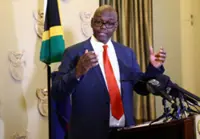A young person reading by the light of a lamp made by the Berlin-based solar energy company Little Sun. — Little Sun/dpa
Many parts of the world, when seen from space, still shine bright when the sun goes down. Which makes the large parts of the African continent especially stand out for remaining in the dark.
Many people in Africa still don't have access to an energy grid. According to the International Energy Agency (IEA), some 580 million of the 1.3 billion people living in Africa are without energy.
Already a subscriber? Log in
Save 30% OFF The Star Digital Access
Cancel anytime. Ad-free. Unlimited access with perks.




